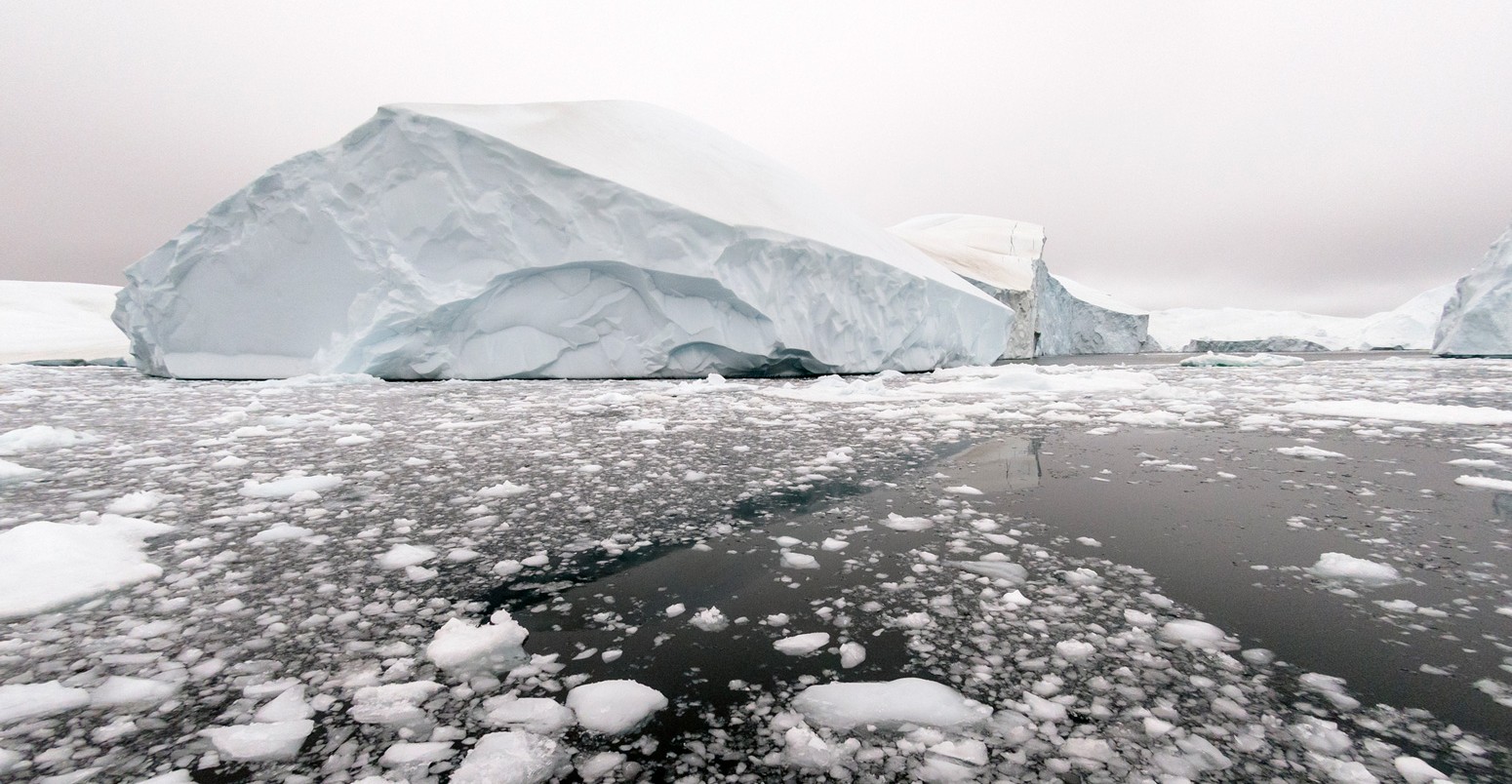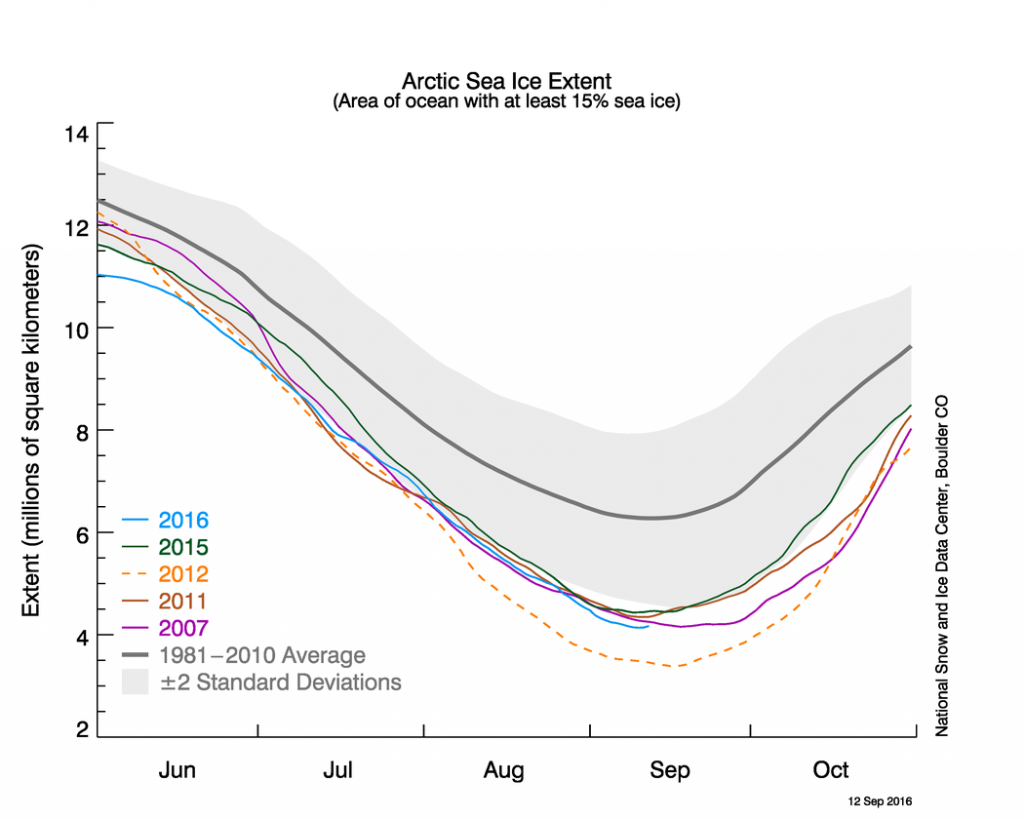
Arctic sea ice summer minimum in 2016 joint-second lowest on record
Robert McSweeney
09.16.16Robert McSweeney
16.09.2016 | 11:31amThe Arctic has hit its summer sea ice minimum for the year, say scientists at the US National Snow and Ice Data Centre (NSIDC), with total ice cover clocking in at 4.14m square kilometres (sq km) on 10 September.
That puts 2016 in a statistical tie with the second lowest summer extent set in 2007, the NSIDC says, with only 2012 recording a smaller extent of 3.39m sq km.

Arctic sea ice extent as of the 12 September 2016 (blue line), along with the four other record low years. The grey line shows the 1981-2010 average, and the shaded area indicates a range of two standard deviations either side of the average. Credit: NSIDC
All 10 of the lowest summer extents in the satellite record have now occurred in the past 10 years, the NSIDC data show.
However, the sea ice measurements for this year are still preliminary, notes the NSIDC, as “changing winds or late-season melt could still reduce the Arctic ice extent”.
New ‘normal’
Scientists have been tracking the daily changes in Arctic sea ice cover using satellites in a continuous record that stretches back to 1979. Notable events, such as the annual minimum and maximum extents, serve as an indicator of how the Arctic is changing as global temperatures rise.
Since hitting its lowest winter maximum on record in March, Arctic sea ice has been on its annual decline through the melt season of spring and summer.
Scientists keep a close eye around the time the low is normally reached – usually early-to-mid september – then look for signs of ice accumulating again in order to pinpoint exactly when the summer minimum extent is reached.
This year’s summer minimum came in as the joint-second smallest on record despite cool and stormy Arctic weather in recent months, says Prof Julienne Stroeve, professor of polar observation & modelling at University College London and senior research scientist at NSIDC. She tells Carbon Brief:
The 2016 summer minimum continues the trend of declining sea ice extent, she adds:
Not including 2016, Arctic sea ice extent at the end of the summer in September has decreased by 13.4% per decade since the satellite record began.

Map of Arctic sea ice extent on 10 September 2016. Orange line shows median sea ice cover for 1981-2010. Black cross indicates the North Pole. Credit: NSIDC
Although the summer sea ice minimum extent isn’t a new record low, it might still be for the total volume of sea ice, says Prof Andrew Shepherd, professor of earth observation at the University of Leeds.
Observations of sea ice thickness from the CryoSat satellite show that the Arctic sea ice pack was around 5cm thinner than usual ahead of this summer’s melting season, Shepherd says:
But we’ll have to wait a bit longer for this data to come through, adds Shepherd:
Record-breaking year
As global average temperatures have reached new highs through 2015 and 2016 – including an ongoing streak of 15 consecutive months of record-breaking temperatures – records have also tumbled for this year’s sea ice.
The Arctic winter hit record lows for sea ice extent for the months of January and February, and a winter maximum extent in March that was the smallest since satellite records began in 1979.
Abnormally warm winter conditions – sometimes 4-8C higher than average – meant slower ice growth for much of the Arctic. The lower than average buildup of ice led scientists to warn in April that 2016 could see a new record low ice extent come the end of the summer.
Records continued to fall during spring, with the months of April, May and June all hitting new lows for sea ice extent. During June, for example, ice extent averaged 10.6m sq km – 260,000 sq km below the previous record set in 2010.
Stormy conditions and lower than average temperatures in late June and into July then brought a slowing of ice melt. The windy weather saw the formation of several polynas – patches of open water within the sea ice that are very effective factories for producing sea ice..
July has been “cloudy and cool, with winds that tend to disperse the ice and increase its extent, rather than compact it.” @NSIDC_ArcticIce
— Robert McSweeney (@rtmcswee) August 4, 2016
Sea ice extent for July was 8.13m sq km, making it the third lowest on record, at around 190,000 sq km greater than 2011. At that point, scientists advised that a new record low extent at the end of the summer was “unlikely”.
#Arctic sea ice extent currently tracking 3rd lowest in satellite record (after 2007 & 2012), says @NSIDC_ArcticIcehttps://t.co/qeppc7afgw
— Robert McSweeney (@rtmcswee) August 23, 2016
For August, average sea ice extent was the fourth lowest on record, and below the 1981-2010 average across almost all of the Arctic, except for a small area in the Laptev Sea above Siberia. Then, in early September, faster than average melt saw the summer minimum dwindle to the joint-second lowest on record.
For those keen to read more about Arctic sea ice, take a look a Carbon Brief’s recent guest posts on piecing together the Arctic’s sea ice history, predicting the Arctic’s first ice-free summer, and the implications of ice loss for Arctic shipping.

